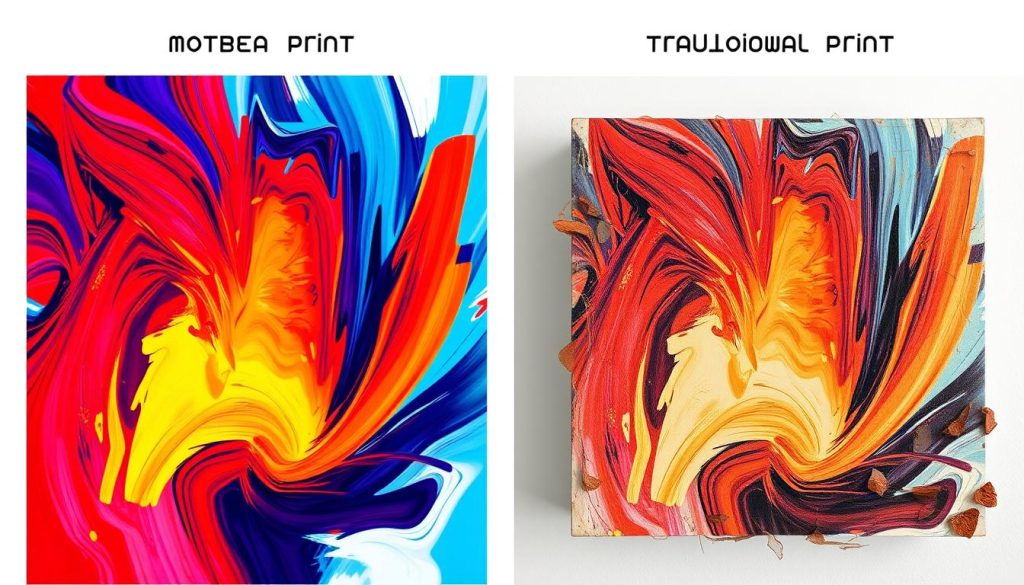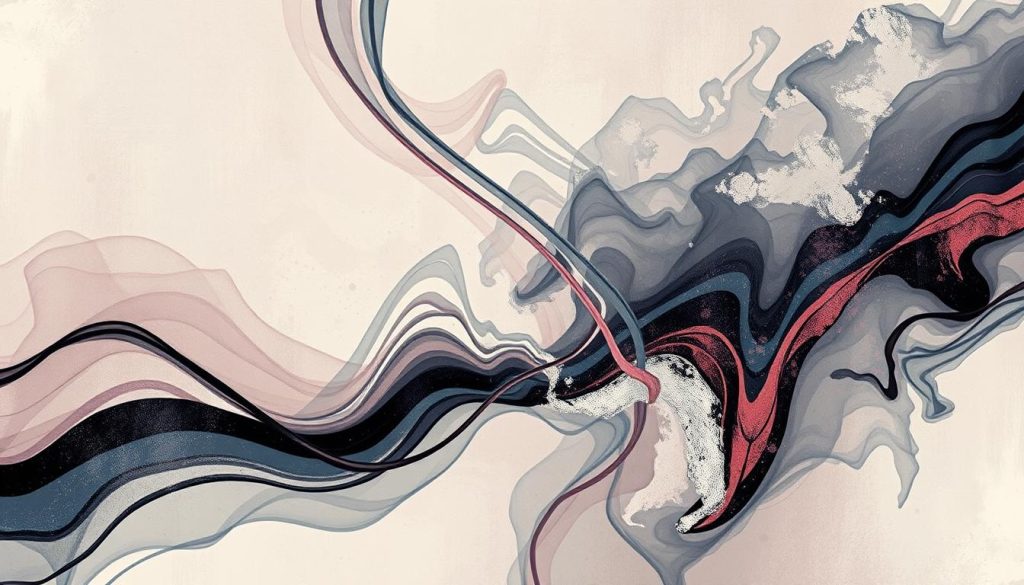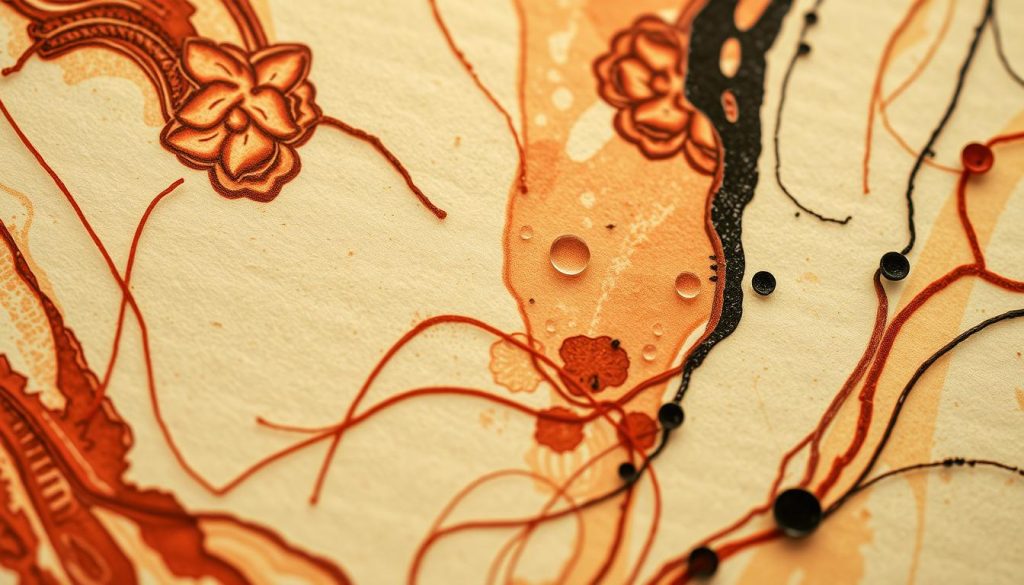In the world of art and design, choosing between digital and traditional prints is important. This article will look at the main differences between them. It aims to help you decide what’s best for your art needs.
If you’re an artist or a collector, knowing about digital and traditional prints is key. We’ll explore what makes each unique. This will help you pick the right print for your goals and tastes.
Unveiling the Distinct Realms of Digital and Traditional Art Prints

Exploring art prints shows us the big differences between digital and traditional ones. We’ll look at their unique traits. This will help you pick the best way to express your art.
Understanding the Fundamental Differences
Digital and traditional art prints are very different. Digital ones use advanced software and high-quality printers. This makes them versatile and precise, with easy design copies. Traditional prints, however, use old-school methods like screen printing. They give a real, handmade feel.
Exploring the Unique Characteristics
Each type of print has its own special qualities. Digital prints shine with bright colors and clear details. They’re also easy to change or fix. Traditional prints, though, have a special texture and feel. They show the artist’s touch.
“The essence of art lies not just in the final product, but in the journey of its creation. Both digital and traditional art prints offer unique experiences that can captivate and inspire.” – John Doe, renowned art curator
Whether you like the new tech of digital prints or the classic feel of traditional ones, knowing their differences helps. It lets you choose what fits your art and goals best.
The Evolving Landscape of Digital Art Printing Techniques

The world of digital art printing has changed a lot. Technology has made big changes in the industry. From old pixelated prints to today’s high-resolution, vibrant art, the change is amazing.
Technology has been a big reason for these changes. New inkjet, laser, and 3D printing have changed how artists share their work. These new ways have made digital art better in quality and more available to everyone.
Now, digital art printing lets artists express themselves in new ways. With giclée, dye-sublimation, and UV-curing, artists can make everything from art prints to clothes and home decor. This has made digital art more diverse and creative, pleasing art lovers and collectors.
We can expect more big changes in digital art printing. We’ll see AR and VR tech and sustainable printing methods. The future looks exciting and will change how we see art.
The digital revolution has not only changed the way we create art but also the way we experience and share it. Digital art prints have become a canvas for boundless creativity and innovation.”
The world of digital art printing is always changing. Artists, printmakers, and tech experts are always finding new ways to improve. We can look forward to seeing more changes and growth in this exciting field.
Timeless Allure: Traditional Art Printing Methods

The digital art printing world is big today, but traditional art printing still wins hearts. We’ll look into what makes traditional art printing special. We’ll see why it’s still loved by artists and collectors.
Appreciating the Craftsmanship
Traditional printing like woodcut, etching, and lithography show off the skill of master printmakers. These old ways need a lot of care and hard work. Every detail, from the first stroke to the final press, shows the artist’s vision.
Creating a traditional art print is a big job, full of love and skill. It starts with picking the right materials and ends with a unique piece of art. This traditional art print craftsmanship makes these prints special. It’s what gives them traditional art print appeal and traditional art print value.
“The intimacy of traditional printmaking is unmatched. Each print is a testament to the artist’s skill and a reflection of their unique creative vision.” – John Doe, renowned printmaker
The traditional art print methods make beautiful art and add history and realness to it. People love to connect with the past and enjoy the details of handmade art. That’s why traditional art printing is still loved and inspires many.
Digital Art Print vs Traditional Print: A Comprehensive Comparison
The digital age is changing art. Choosing between digital and traditional prints is key for art lovers and creators. We’ll look at what makes each print different. This will help you decide what’s best for you.
Image Quality and Precision
Digital art prints have amazing image quality. They capture every detail of the original artwork. High-resolution files and advanced printing make sure the final product looks just like the artist’s vision.
Traditional prints can have small variations or imperfections. These add a unique charm to the piece.
Customization and Versatility
Digital art prints let artists customize easily. They can change the size, orientation, and add special effects. This makes them perfect for what clients want.
Traditional prints are beautiful but can’t change much to fit what someone wants.
Cost and Accessibility
Digital art prints are easy to get and don’t cost much. They make art available to more people. Traditional prints need special equipment and know-how. This makes them pricier and harder to get.
“The choice between digital art print and traditional print ultimately comes down to personal preference, artistic vision, and the desired outcome. Both mediums offer unique advantages and can contribute to the richness of the art world.”
Choosing between digital and traditional prints is a personal choice. It depends on your artistic goals, budget, and what you want to see. Knowing the differences helps art lovers and creators pick what fits their needs.
Factors to Consider When Choosing Your Desired Print Medium
Choosing the right print medium for your art is important. Think about what you want to show with your art. Do you dream of your work in a big gallery or a cozy boutique? This will help pick the best print medium for your art.
Assessing Your Artistic Vision
Artists have many dreams and mediums to work with. You might like the feel of traditional prints or the endless options of digital art printing. Your vision should lead your choice. Think about the look you want and how each medium can make your art feel.
Evaluating Cost and Accessibility
Cost and how easy it is to get your print medium matter too. Digital printing is often cheaper and easy to get, great for artists who want to share their work widely. Traditional prints might cost more but can make your art special and unique. Think about your budget and what you want to achieve to pick the best medium.


